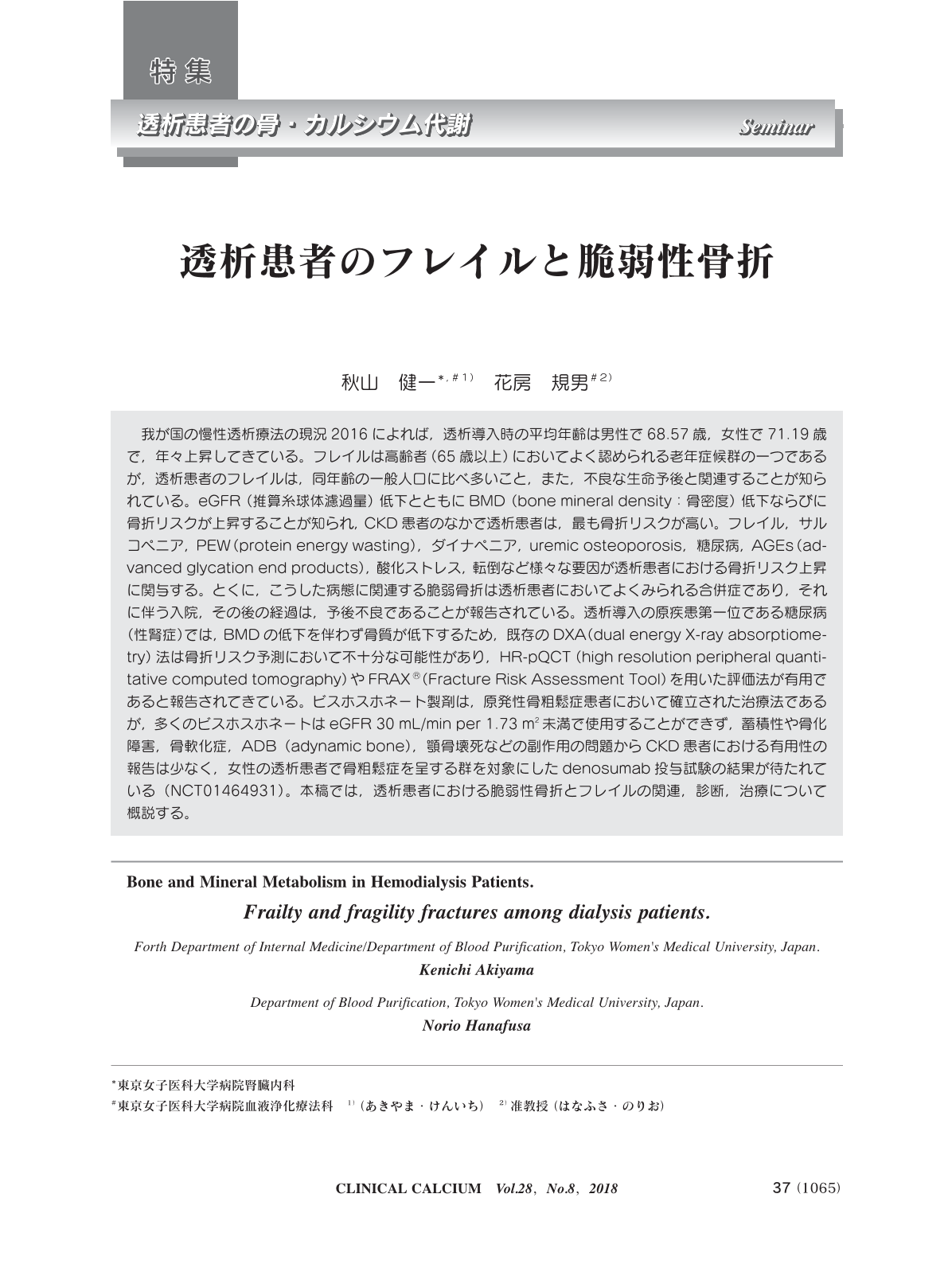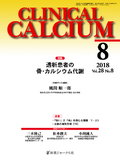Japanese
English
- 有料閲覧
- Abstract 文献概要
- 1ページ目 Look Inside
- 参考文献 Reference
我が国の慢性透析療法の現況2016によれば,透析導入時の平均年齢は男性で68.57歳,女性で71.19歳で,年々上昇してきている。フレイルは高齢者(65歳以上)においてよく認められる老年症候群の一つであるが,透析患者のフレイルは,同年齢の一般人口に比べ多いこと,また,不良な生命予後と関連することが知られている。eGFR(推算糸球体濾過量)低下とともにBMD(bone mineral density:骨密度)低下ならびに骨折リスクが上昇することが知られ,CKD患者のなかで透析患者は,最も骨折リスクが高い。フレイル,サルコペニア,PEW(protein energy wasting),ダイナペニア,uremic osteoporosis,糖尿病,AGEs(advanced glycation end products),酸化ストレス,転倒など様々な要因が透析患者における骨折リスク上昇に関与する。とくに,こうした病態に関連する脆弱骨折は透析患者においてよくみられる合併症であり,それに伴う入院,その後の経過は,予後不良であることが報告されている。透析導入の原疾患第一位である糖尿病(性腎症)では,BMDの低下を伴わず骨質が低下するため,既存のDXA(dual energy X-ray absorptiometry)法は骨折リスク予測において不十分な可能性があり,HR-pQCT(high resolution peripheral quantitative computed tomography)やFRAX(Fracture Risk Assessment Tool)を用いた評価法が有用であると報告されてきている。ビスホスホネート製剤は,原発性骨粗鬆症患者において確立された治療法であるが,多くのビスホスホネートはeGFR 30 mL/min per 1.73 m2未満で使用することができず,蓄積性や骨化障害,骨軟化症,ADB(adynamic bone),顎骨壊死などの副作用の問題からCKD患者における有用性の報告は少なく,女性の透析患者で骨粗鬆症を呈する群を対象にしたdenosumab投与試験の結果が待たれている(NCT01464931)。本稿では,透析患者における脆弱性骨折とフレイルの関連,診断,治療について概説する。
According to the current status of chronic dialysis therapy in Japan 2016, the average age at the time of dialysis initiation is 68.57 years for males and 71.19 years for females, which has been rising continuously. Frailty is a geriatric syndrome that is frequently seen in the elderly. It is known that frailty among dialysis patients are more common than the general population of the same age, and that frailty is associated with life prognosis. As eGFR decreases, BMD decreases and fracture risk increase, and dialysis patients are at the highest risk of fracture in CKD patients. Various factors such as frailty, sarcopenia, PEW(protein-energy wasting), dynapenia, uremic osteoporosis, diabetes, AGEs(advanced glycation end products), oxidative stress, falls are involved in the increased risk of fracture in dialysis patients, and consequently, fragile fractures occur frequently in dialysis patients. Fragile fracture is a common complication in dialysis patients, and it is reported that the hospitalization for fracture, and the subsequent course is associated with poor prognosis. In diabetes, bone quality declines without loss of BMD, so the conventional DXA method may be insufficient in predicting fracture risk among dialysis patients, and the evaluation method using HR-pQCT or FRAX® may be useful. It has been reported that bisphosphonate is an established therapy in patients with primary osteoporosis, but many bisphosphonates cannot be used at eGFR of less than 30 mL/min per 1.73 m2. Bisphosphonate-related adverse effects such as accumulation, ossification, osteomalacia, ADB(adynamic bone), and jaw bone necrosis were reported, there are few reports of usefulness in CKD patients. Denosumab administration trial results for women with osteoporosis in dialysis patients have been waited(NCT 01464931). In this article, we outline the relation, diagnosis, and treatment of fragile fractures and frailty in dialysis patients.



